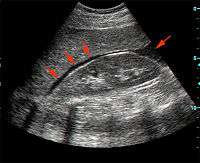Focused assessment with sonography for trauma
| Focused assessment with sonography for trauma | |
|---|---|
| Diagnostics | |
| eMedicine | 104363 |
Focused assessment with sonography for trauma (commonly abbreviated as FAST) is a rapid bedside ultrasound examination performed by surgeons, emergency physicians and certain paramedics as a screening test for blood around the heart (pericardial effusion) or abdominal organs (hemoperitoneum) after trauma.[1]
The four classic areas that are examined for free fluid are the perihepatic space (also called Morison's pouch or the hepatorenal recess), perisplenic space, pericardium, and the pelvis. With this technique it is possible to identify the presence of intraperitoneal or pericardial free fluid. In the context of traumatic injury, this fluid will usually be due to bleeding.
Extended FAST
The extended FAST (eFAST) allows for the examination of both lungs by adding bilateral anterior thoracic sonography to the FAST exam. This allows for the detection of a pneumothorax with the absence of normal ‘lung-sliding’ and ‘comet-tail’ artifact (seen on the ultrasound screen). Compared with supine chest radiography, with CT or clinical course as the gold standard, bedside sonography has superior sensitivity (49–99 versus 27–75%), similar specificity (95–100%), and can be performed in under a minute.[2] Several recent prospective studies have validated its use in the setting of trauma resuscitation, and have also shown that ultrasound can provide an accurate estimation of pneumothorax size.[3][4] Although radiography or CT scanning is generally feasible, immediate bedside detection of a pneumothorax confirms what are often ambiguous physical findings in unstable patients, and guides immediate chest decompression. In addition, in the patient undergoing positive-pressure ventilation, the detection of an otherwise ‘occult’ pneumothorax prior to CT scanning may hasten treatment and subsequently prevent development of a tension pneumothorax, a deadly complication if not treated immediately, and deterioration in the radiology suite (in the CT scanner).[5]
Advantages

FAST is less invasive than diagnostic peritoneal lavage, involves no exposure to radiation and is cheaper compared to computed tomography, but achieves a similar accuracy.[6]
Numerous studies have shown FAST is useful in evaluating trauma patients.[7][8][9][10] It also appears to make emergency department care faster and better.[11][12]
Interpretation

FAST is most useful in trauma patients who are hemodynamically unstable. A positive FAST result is defined as the appearance of a dark ("anechoic") strip in the dependent areas of the peritoneum. In the right upper quadrant this typically appears in Morison's Pouch (between the liver and kidney). This location is most useful as it is the place where fluid will collect with a supine patient. In the left upper quadrant, blood may collect anywhere around the spleen (perisplenic space). In the pelvis, blood generally pools behind the bladder (in the rectovesicular space). A positive result suggests hemoperitoneum; often CT scan will be performed if the patient is stable[13] or a laparotomy if unstable. In those with a negative FAST result, a search for extra-abdominal sources of bleeding may still need to be performed.[13] Rip's absent organ sign has been described as suggestive for diaphragmatic rupture.[14]
See also
References
- ↑ http://www.sonoguide.com/FAST.html
- ↑ Kirkpatrick AW, Sirois M, Laupland KB, et al., J Trauma, 2004;57(2):288–95.
- ↑ Zhang M, Liu ZH, Yang JX, et al., Crit Care, 2006;10(4):R112.
- ↑ Blaivas M, Lyon M, Duggal SA, Acad Emerg Med, 2005;12(9):844–9.
- ↑ Davis JA, et al. Critical Diagnosis in Bedside Ultrasonography. Diagnostics & Imaging. 2007.
- ↑ Rozycki G, Shackford S (1996). "Ultrasound, what every trauma surgeon should know". J Trauma. 40 (1): 1–4. doi:10.1097/00005373-199601000-00001. PMID 8576968.
- ↑ Dolich MO, McKenney MG, Varela JE, Compton RP, McKenney KL, Cohn SM (Jan 2001). "2,576 ultrasounds for blunt abdominal trauma". Journal of Trauma. 50 (1): 108–12. doi:10.1097/00005373-200101000-00019. PMID 11231679.
- ↑ Farahmand N, Sirlin CB, Brown MA, Shragg GP, Fortlage D, Hoyt DB, Casola G (May 2005). "Hypotensive patients with blunt abdominal trauma: performance of screening US". Radiology. 235 (2): 436–43. doi:10.1148/radiol.2352040583. PMID 15798158.
- ↑ Sirlin CB, Brown MA, Andrade-Barreto OA, Deutsch R, Fortlage DA, Hoyt DB, Casola G (Mar 2004). "Blunt abdominal trauma: clinical value of negative screening US scans". Radiology. 230 (3): 661–8. doi:10.1148/radiol.2303021707. PMID 14990832.
- ↑ Moylan M, Newgard CD, Ma OJ, Sabbaj A, Rogers T, Douglass R (Oct 2007). "Association between a positive ED FAST examination and therapeutic laparotomy in normotensive blunt trauma patients". Journal of Emergency Medicine. 33 (3): 265–71. doi:10.1016/j.jemermed.2007.02.030. PMID 17976554.
- ↑ Melniker LA, Leibner E, McKenney MG, Lopez P, Briggs WM, Mancuso CA (Sep 2006). "Randomized controlled clinical trial of point-of-care, limited ultrasonography for trauma in the emergency department: the first sonography outcomes assessment program trial". Annals of Emergency Medicine. 48 (3): 227–35. doi:10.1016/j.annemergmed.2006.01.008. PMID 16934640.
- ↑ Ollerton JE, Sugrue M, Balogh Z, D'Amours SK, Giles A, Wyllie P (Apr 2006). "Prospective study to evaluate the influence of FAST on trauma patient management". Journal of Trauma. 60 (4): 785–91. doi:10.1097/01.ta.0000214583.21492.e8. PMID 16612298.
- 1 2 Scalea T, Rodriguez A, Chiu W, Brenneman F, Fallon W, Kato K, McKenney M, Nerlich M, Ochsner M, Yoshii H (1999). "Focused Assessment with Sonography for Trauma (FAST): results from an international consensus conference". Journal of Trauma. 46 (3): 466–72. doi:10.1097/00005373-199903000-00022. PMID 10088853.
- ↑ Gangahar R, Doshi D (2009). "FAST scan in the diagnosis of acute diaphragmatic rupture". Am J Emerg Med. 28 (3): 387. doi:10.1016/j.ajem.2009.07.004. PMID 20223407.
- Further reading
- Gillman, Lawrence M; Ball, Chad G; Panebianco, Nova; Al-Kadi, Azzam; Kirkpatrick, Andrew W (2009). "Clinician performed resuscitative ultrasonography for the initial evaluation and resuscitation of trauma". Scandinavian Journal of Trauma, Resuscitation and Emergency Medicine. 17 (1): 34. doi:10.1186/1757-7241-17-34.
External links
- Focus On: EFAST - Extended Focused Assessment With Sonography for Trauma: American College of Emergency Physicians (ACEP)
- eMedicine: Blunt abdominal trauma
- FAST exam tutorial
- The FAST examination from Trauma.org, includes tutorial videos.
- Lung ultrasound: ICU Sonography
- FOB Doc: Capt Ray Wiss, MD. By a pioneering teacher of FAST to ER and first responders, civilian and military.